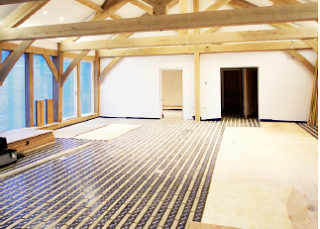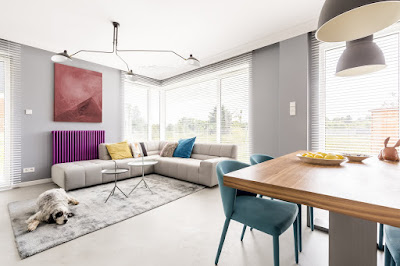Are All Underfloor Heating Systems the Same?
Are All Underfloor Heating Systems the Same?
OMNIE demonstrates that choosing the right underfloor heating system can save up to 30% on running costs.
 Underfloor heating can be successfully installed into many different floor constructions from concrete screed to acoustic timber battens. But is it reasonable to presume that all these different constructions perform in the same way? The performance of an underfloor heating system depends on two factors- the physical construction or dimensioning of the system and the temperature difference between the water used and the room.
Underfloor heating can be successfully installed into many different floor constructions from concrete screed to acoustic timber battens. But is it reasonable to presume that all these different constructions perform in the same way? The performance of an underfloor heating system depends on two factors- the physical construction or dimensioning of the system and the temperature difference between the water used and the room.
Temperature
The rate of heat transfer is dependent on the temperature gradient between the underfloor heating system and the room. The bigger the difference the bigger the transfer of energy. When the water temperature and the air temperature are the same, there will be no heat transfer. As the floor begins to warm up, heat begins to move between the underfloor heating pipe and the room.
 The speed at which the heat is transferred is dependent on the construction of the floor and the design of the underfloor heating system within it.
The speed at which the heat is transferred is dependent on the construction of the floor and the design of the underfloor heating system within it.
Construction
The physical construction determines the characteristics of the underfloor heating system. The pipe centres, the type of floors, the floor finish, where the pipe is installed and the type of pipe all have bearing on the heat output of the floor. Fundamentally all these factors either aid or limit the flow of heat from the pipe to the floor surface. For example, the more resistant the floor finish, the lower the heat output, and more conductive the floor construction. This means more heat will be transferred.
How do different underfloor heating systems perform?
OMNIE has tested several dry construction underfloor heating systems such as those used in batten, suspended and floating floors to understand how warm the water needs to be to generate enough heat to overcome the average new-build heat loss.
Our investigation that was conducted at the independent test chamber at BSRIA, showed that the water temperatures needed by an underfloor heating system to produce 50 W/ m2 varied depending on the type of system. As the temperature of the water produced by a boiler of heat pump dictates its efficiency, it is important to run the system with the lowest possible water temperature.
The examples below demonstrate the water temperature needed by several dry construction underfloor heating systems to produce 50W/m2 (this being the average heat loss for a new build house with an outside air temperature of -30c external).
By knowing what water temperature is needed, we can understand the COP that the heat pump will run at and from this the annual running cost for an average house.
And if I have an older house with a higher heat loss?
Importantly underfloor heating products that are designed to be used with low water temperatures will also provide extra output when used with conventional high temperature heat sources such as condensing boilers. This makes these products better suited for overcoming higher heat losses experienced with older buildings. 



Comments
Post a Comment